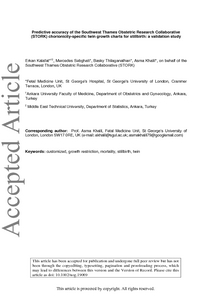Kalafat, E; Sebghati, M; Thilaganathan, B; Khalil, A; Southwest Thames Obstetric Research Collaborative (STORK)
(2019)
Predictive accuracy of the Southwest Thames Obstetric Research Collaborative (STORK) chorionicity-specific twin growth charts for stillbirth: a validation study.
Ultrasound Obstet Gynecol, 53 (2).
pp. 193-199.
ISSN 1469-0705
https://doi.org/10.1002/uog.19069
SGUL Authors: Khalil, Asma
![[img]](https://openaccess.sgul.ac.uk/109772/1.hassmallThumbnailVersion/Kalafat_et_al-2017-Ultrasound_in_Obstetrics_%2526_Gynecology.pdf)  Preview |
|
PDF
Accepted Version
Available under License ["licenses_description_publisher" not defined].
Download (1MB)
| Preview
|
Abstract
OBJECTIVE: Twin pregnancy is associated with 2-3 fold increased risk of stillbirth compared to singletons. Despite the fact that the growth pattern has been shown to differ in twins compared to singletons, it is controversial whether twin-specific growth charts should be routinely used. A major goal of prenatal ultrasound is to identify fetuses suffering from growth restriction at risk of stillbirth. The main aim of this study was to compare the performance of chorionicity-specific twin charts with singleton charts, both customized and non-customized, in the antenatal prediction of small-for-gestational age (SGA) stillborn and liveborn fetuses. METHODS: This was a multicenter cohort study analyzing data from the Southwest Thames Obstetric Research Collaborative (STORK) multiple pregnancy cohort (2000-2009) and a second cohort of twin pregnancies at St. George's University Hospital (SGH) (2011-2016). The former cohort was used to compare the performance of the twin and non-customized (Poon) singleton charts. The latter cohort was used to compare the performance of the twin, customized (Gestation Related Optimal Weight [GROW]) and non-customized (Poon) singleton charts. The primary outcome was the prediction of SGA cases that were stillborn and liveborn in twin pregnancies. The estimated fetal weight (EFW) available from the last scan (24 weeks' gestation and onwards) before delivery or demise was used to classify the fetuses as SGA (<10th centile, <3rd centile) or appropriate for gestational age. The proportions of SGA stillbirths and SGA livebirths predicted were calculated using the three different charts. RESULTS: The STORK cohort consisted of 1850 dichorionic (DC) and 300 monochorionic (MC) twin pregnancies. The SGH cohort consisted of 579 DC and 180 MC twin pregnancies. The stillbirth rate in the STORK and SGH cohorts were 1.1% and 1.3%, respectively. In those liveborn in the STORK cohort, using a 10th centile cut-off to define SGA, the non-customized singleton chart identified a significantly greater proportion as SGA compared to the twin chart, regardless of chorionicity (p<0.001). However, there was no significant difference between the twin and the non-customized singleton charts in regards to in the proportion of stillbirth cases that were SGA (p=0.479). In the SGH cohort, the non-customized singleton chart identified 8.5% of all liveborn fetuses as SGA (<10th centile) compared to 12.8% using the customized singleton chart and 7.1% using the twin chart (p=0.005 and p<0.001, respectively). However, there was no significant difference among the three charts in the proportion of stillbirths identified as SGA, regardless of chorionicity (p=0.999). Similar results were obtained when the third centile cut-off was used to define SGA. CONCLUSIONS: Compared to the STORK chorionicity-specific twin charts, the customized or non-customized singleton charts identified more liveborn fetuses as SGA. However, the three charts identified a similar proportion of stillbirth SGA cases. Our preliminary results suggest that these twin charts could safely reduce unnecessary medical intervention in twin pregnancies. Further research on the topic is needed before clinical recommendations can be made.
| Item Type: |
Article
|
| Additional Information: |
This is the peer reviewed version of the following article: Kalafat, E. , Sebghati, M. , Thilaganathan, B. , Khalil, A. and , (2019), Predictive accuracy of Southwest Thames Obstetric Research Collaborative (STORK) chorionicity‐specific twin growth charts for stillbirth: a validation study. Ultrasound Obstet Gynecol, 53: 193-199, which has been published in final form at https://doi.org/10.1002/uog.19069. This article may be used for non-commercial purposes in accordance with Wiley Terms and Conditions for Self-Archiving. |
| Keywords: |
customized, growth restriction, mortality, stillbirth, twin, Obstetrics & Reproductive Medicine, 1114 Paediatrics And Reproductive Medicine |
| SGUL Research Institute / Research Centre: |
Academic Structure > Molecular and Clinical Sciences Research Institute (MCS) |
| Journal or Publication Title: |
Ultrasound Obstet Gynecol |
| ISSN: |
1469-0705 |
| Language: |
eng |
| Dates: |
| Date | Event |
|---|
| 5 February 2019 | Published | | 16 April 2018 | Published Online | | 6 March 2018 | Accepted |
|
| Publisher License: |
Publisher's own licence |
| PubMed ID: |
29660172 |
 |
Go to PubMed abstract |
| URI: |
https://openaccess.sgul.ac.uk/id/eprint/109772 |
| Publisher's version: |
https://doi.org/10.1002/uog.19069 |
Statistics
Item downloaded times since 01 May 2018.
Actions (login required)
 |
Edit Item |



